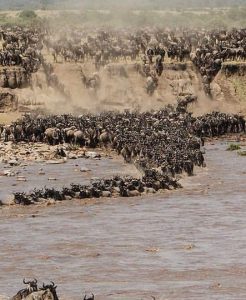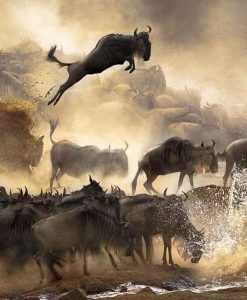Travel information
Tanzania is a generally safe country, but don’t invite temptation. Keep an eye on your belongings. Don’t walk in the towns or cities at night-Take a taxi. Don’t take cameras or large amount of cash also be aware of pickpockets. Do not leave money or valuables in your hotel room and use a safe deposit box. We advise not to come with valuable jewellery you may leave at home.
Tanzania police has established a special tourism unit to take care of the safety requirements of diplomatic mission members and other foreign tourists visiting destinations in the country. We believe that Peace and security are critical factors in attracting more visitors to any destination.
Generally dry and hot with cool nights/mornings from June-October, short rains from November to mid-December, long rains from march-may but the seasons may vary. The coastal strip is hot and humid all year round. Temperatures on Mount Kilimanjaro and Meru may drop to below freezing.
GMT + 3 hours
The Tanzania’s national language is ki-swahili and English is an official language, English is widely spoken but a few words of Swahili can be useful to visitors and will be appreciated greatly by locals. Tanzania has more than 120 different dialects.
The Tanzania’s national language is ki-swahili and English is an official language, English is widely spoken but a few words of Swahili can be useful to visitors and will be appreciated greatly by locals. Tanzania has more than 120 different dialects.
Yellow fever vaccination is mandatory. You will have to show your yellow fever vaccination certificate upon your entry to Tanzania. Malaria is endemic but is preventable, it occurs below 1800 meters and you should use the recommended prophylactics. Please consult your doctor about these. The best way to prevent contracting Malaria for the duration of your Tanzania vacations tour, is to try and avoid mosquito bites by using an insect repellent, by sleeping under mosquito nets and to wear proper clothing after sunset.
Please consult your local travel clinic for the latest recommendations.
Visa is required by most travelers to Tanzania. Check current requirements with the nearest Tanzanian High Commission, Embassy or consulate. You can obtain your visa on arrival at all international airports and overland borders.
Tanzania gets cooler in the evenings and early mornings [especially the months of June/July/August/September] the best advice is to dress in layers with a sweater and light windbreaker. Early morning/night temperature can be around [40-60F].During the day it can rise to around [70-86F].
It is advised not to dress on bright and light colors for a number of reasons.
-Brighter colors are proven to attract tsetse flies.
-Brighter colors are proven to scare the animals.
-Lighter colors show dirt and dust less.
-The neutral range of colors do not absorb heat as much as darker colors and will you cooler.
When it comes to packing, a handy tip to remember is that all lodges and camps provide a daily laundry service which means you don’t have to pack as much.
For climbing on Kilimanjaro or Meru, please take thermal underwear, light layers, sweater, rain jacket, good socks and sturdy boots.
The tourist areas and lodges sell a wide range of souvenirs, jewellery and trinkets. Don’t be afraid to haggle at roadside stalls (your driver guide will advise you where to shop and on a reasonable price). The most popular souvenirs are wooden handcraft, curios, and a famous love stone which is the well-known gem stone “Tanzanite”.
Month-by-month guide for travelling in Tanzania
 This is the time to witness the great wildebeest migration in the Southern Serengeti and Ngorongoro. Exact locations for the best viewing of the migration can vary with each rain season as the migration moves according to the rain patterns. Between January and March, calving happens in the Southern plains of Serengeti. This is quite a spectacle as hundreds of thousands of wildebeest and zebra drop their calves, with predators on hunting. It is also the best time to watch large herds of elephant, large predators and hundreds species of birds in Tarangire national park.
This is the time to witness the great wildebeest migration in the Southern Serengeti and Ngorongoro. Exact locations for the best viewing of the migration can vary with each rain season as the migration moves according to the rain patterns. Between January and March, calving happens in the Southern plains of Serengeti. This is quite a spectacle as hundreds of thousands of wildebeest and zebra drop their calves, with predators on hunting. It is also the best time to watch large herds of elephant, large predators and hundreds species of birds in Tarangire national park.
 The best places to go during this time depend on the timing of the rainy season in any particular year. Some of the wildebeest migration herds will still be in parts of Southern Serengeti and some will be spread out from Southern plains to the central Serengeti areas, and slowly heading to into the western corridor of Serengeti.
The best places to go during this time depend on the timing of the rainy season in any particular year. Some of the wildebeest migration herds will still be in parts of Southern Serengeti and some will be spread out from Southern plains to the central Serengeti areas, and slowly heading to into the western corridor of Serengeti.
The best place to witness the great migration is the western corridor of the Serengeti, along the Grumeti River, Kirawira and Nyasirori plains. This is also the good time to explore Seronera area and Eastern Serengeti for all kinds of animal especially big cats. Central Serengeti is all year round accessible for game viewing activities. Explore Tarangire National Park, one of the greatest wildlife refuges in Africa with less number of tourists.
This is the best time and one of the highest seasons for visitors. The vegetation is relatively getting dry and animals gather around permanent water’s points. The wildebeest migration at this time will be around Mara River in the Northern Serengeti. This is the best time you can witness the migration crossing with crocodiles attack. Tarangire National Park is really worth visiting during this time as large herds of elephant, zebra and wildebeest are easily seen along the Tarangire River and Silalei Swamp while predators lying in wait.
This is the short rainy season the vegetation is turning greener and beautiful landscapes in Tarangire, Ngorongoro crater and Serengeti. While Christmas and New Year is the highest season to do safari in Northern Tanzania, November and December other than the holidays are relatively quiet times to come, though there’s still more to see. If you want to witness the great migration herds, it is likely to see them at Eastern, some parts of Central and Southern Serengeti. This is the best time to come as it is less crowded with tourists, so you will have a quieter experience while the wildlife is abundant.
Creating tailor-made tours for over 10 years
Due to Tanzania’s close proximity to the equator, we generally only have two seasons; a rainy season and dry season. Short rainy season is from November to January and long rainy season is March through May. Dry season usually starts from July to October.
Majority of people will suggest that the best time to visit Tanzania is between July to October. This is the dry season, means that animals wandering searching for water, which makes them relatively easy to spot. You will probably see them in large concentrations as the watering points and rivers are getting limited. Most of the water’s sources dry up or get smaller during the dry season. However because most people believe that July to October is the best time to come, it is also the busiest time in the national parks. This means that majority of people miss the hidden treasures that can be found at other times of the year.
Here is a short overview of what the year looks like in our National Parks.
Ideas and travel guides for exploring Tanzania
High Season
- From June to October
- It is the dry season
- Climate: Dry and warm, although there is short rains between August and September
- Higher rates applied Great Migration Mara River crossing
Recommended Itineraries
- Great Migration River Crossing
- Kilimanjaro and Safari adventure
- Cultural and Great Migration experience
- Serengeti Migration and Zanzibar
- Kenya and Tanzania Game Safari
- Tanzania Camping Safari
Mid Season
- From November to February
- It is the short rains season
- Climate: Short rains, hot and dry in some days
- Average rates applied
- Great Migration Southern Serengeti (Calving Season)
Recommended Itineraries
- Special Green Season
- Wildebeest Migration and Cultural Safari
- Tanzania Signature Safari
- Tanzania Luxury Safari
- Tanzania Safari Adventure
Low Season
- From March to May
- Long rain season
- Climate: Rainy days, occasionally warm
- Lower rates applied
- Great Migration safari Southern to central Serengeti
Recommended Itineraries
- Special Green Season
- Tanzania Highlights Safari
- Wildebeest Migration and Cultural Safari